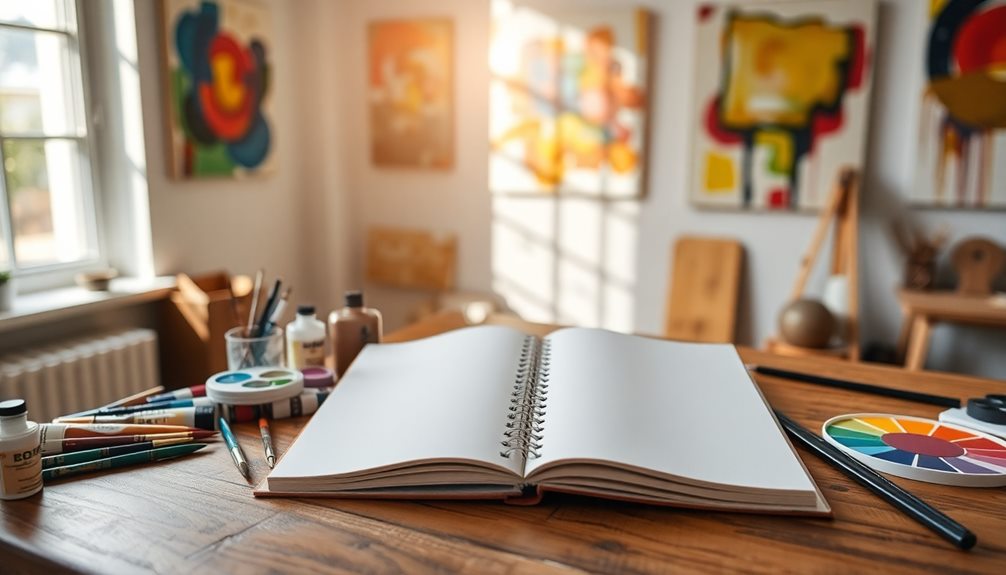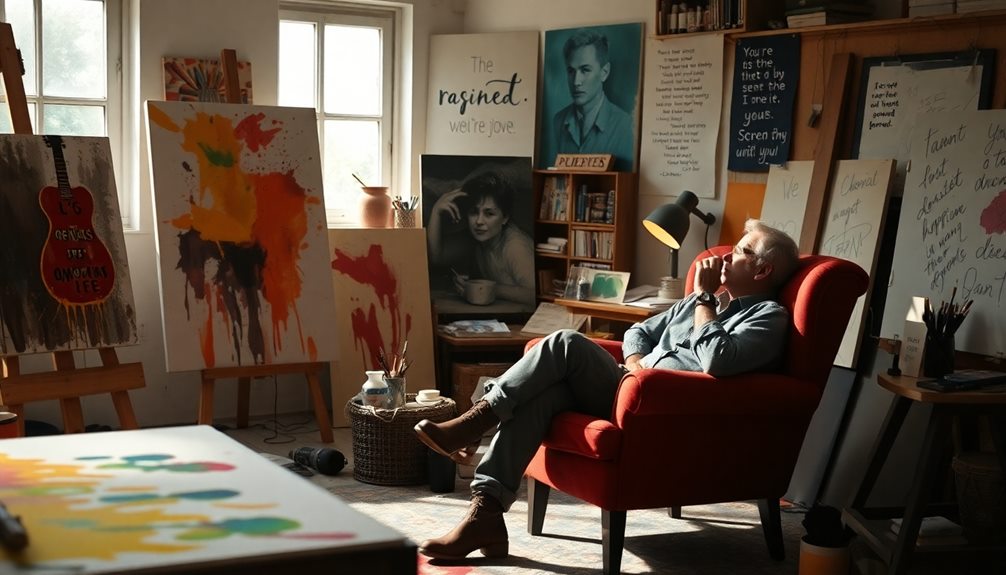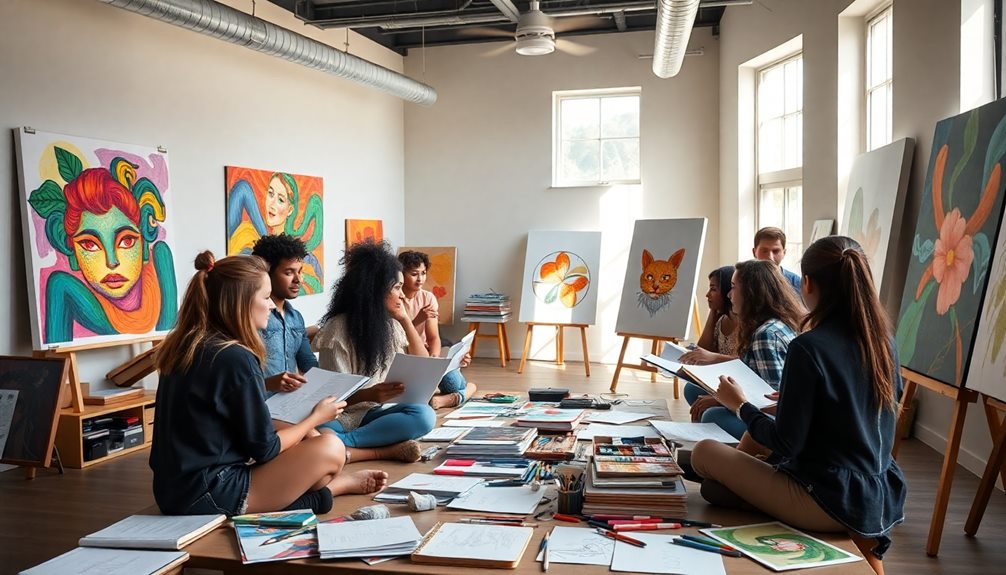To grasp the essentials of art theory, start by familiarizing yourself with key concepts like mimesis, symbolism, and abstraction. Understand how historical contexts shape artistic movements and influence audience interpretation. Use formal and contextual analysis frameworks to evaluate artworks effectively. Engage with artists' insights to gain perspective on their creative processes. Moreover, embrace audience engagement as it enriches your experience and appreciation of art. Finally, keep updated on contemporary trends to stay connected with the evolving discussions in this field. There's plenty more to explore about how these elements intertwine and deepen your understanding of art theory.
Key Takeaways
- Art theory examines artistic expression's significance, shaped by societal influences and historical perspectives from thinkers like Plato and Kant.
- Key concepts like mimesis, symbolism, and abstraction enhance understanding of how art reflects cultural environments and conveys deeper meanings.
- Analyzing art requires both formal and contextual approaches, considering visual elements alongside historical and cultural backgrounds.
- Engaging with artists' insights and audience feedback fosters a deeper connection with artworks and informs future artistic practices.
- Utilize recommended resources like academic databases and key texts to enrich your study of art theory and its contemporary relevance.
Introduction

Art theory is a multifaceted field that explores the essence and significance of art, weaving together philosophical, aesthetic, and cultural insights. The purpose of art theory is to understand the nature, value, and impact of artistic expression.
By examining how societal influences shape art, you gain a deeper appreciation for the intricate relationship between culture and creativity. For instance, urban themes in contemporary Indian painting reflect the rapid modernization of society and its impact on artistic narratives.
Historical development in art theory highlights contributions from thinkers like Plato, Aristotle, and Kant, each shaping the way we perceive art throughout the ages. Their ideas have influenced major movements, including Modernism and Postmodernism, guiding artists in their creative journeys.
Art criticism plays a crucial role within this framework, as it evaluates and contextualizes artworks, fostering dialogue between creators and audiences. This exchange enhances public understanding and appreciation for diverse artistic practices.
Today, contemporary trends in art theory emphasize technology's impact, inclusivity in narratives, and active viewer engagement. These elements reflect the dynamic landscape of artistic expression, urging you to explore and question your relationship with art.
In this guide, you'll delve deeper into these concepts, enriching your understanding of art's evolving nature.
Key Concepts and Definitions

In exploring the world of art theory, you'll encounter several key concepts that shape your understanding of artistic expression. Art theory encompasses the study of the nature, value, and purpose of art, diving into aesthetic principles and philosophical questions.
One crucial concept is mimesis, which refers to the imitation of reality, often highlighted in discussions of authenticity and existence. You'll also find symbolism, where artists use symbols to convey deeper meanings, and abstraction, which involves non-representational forms that challenge traditional perceptions of art.
Aesthetic experience is another vital aspect; it describes how you engage with and perceive art, influenced by personal, cultural, and contextual factors. As you study art theory and criticism, you'll explore the intricate relationship between artistic representation and reality, examining how art can reflect or distort the world around you.
Critical perspectives play a significant role in enhancing your appreciation and comprehension of art. They offer frameworks for evaluating and interpreting artistic works within their cultural context, helping you understand the broader implications of art in society.
Embracing these key concepts will deepen your engagement with art and enrich your journey through art theory.
Art Analysis Framework

An effective art analysis framework helps you dissect and understand the layers of meaning within a piece of artwork. This framework typically includes formal analysis, where you focus on visual elements like line, color, and composition. By examining these aspects, you gain insight into the artist's choices and intentions.
Additionally, contextual analysis is crucial; it involves considering the historical and cultural background that shapes the artwork. This understanding is particularly enhanced by exploring how art theory influences creativity, as it can deepen your appreciation for various art forms and techniques.
You should evaluate the relationship between the artwork and its audience, as the intended audience can significantly influence interpretation. Exploring psychoanalytic approaches helps you delve into the psychological dimensions and emotional responses elicited by the piece.
Moreover, interdisciplinary methods enhance your analysis by incorporating perspectives from sociology, anthropology, and other fields, providing a more holistic understanding of the artwork's significance in art history.
Critical frameworks, such as feminist and postcolonial critiques, challenge traditional narratives and highlight underrepresented voices.
Artist Interviews and Insights

Understanding the layers of meaning in art often leads to a greater appreciation of the artists themselves. Artist interviews serve as a window into the creative processes, inspirations, and challenges that shape their work.
When you engage with these conversations, you gain valuable insights that enhance your understanding of art theory. You'll discover how artists discuss the techniques and materials they use, emphasizing the importance of medium and technique in their artistic expression.
These discussions often explore the cultural and social contexts influencing their work, allowing you to see how societal issues are reflected in their art. As you listen to artists articulate their motivations and experiences, you'll start interpreting art through their lens, grasping their understanding of beauty, aesthetics, and purpose.
This personal perspective fosters a deeper connection to contemporary art, enriching your experience and appreciation. By analyzing artist interviews, you're not just looking at the artwork itself but also understanding the thoughts and intentions behind it.
This holistic approach to art enhances your ability to appreciate and engage with diverse artistic expressions.
Tips and Best Practices

To master art theory effectively, you should start by familiarizing yourself with key terminology like mimesis, symbolism, and aesthetics. Understanding these concepts helps clarify the role and purpose of various artistic movements and critiques.
Next, engage with different methodologies in art criticism, such as formal, contextual, and psychoanalytic approaches. This broadens your perspective and equips you to evaluate art more comprehensively.
It's essential to explore the historical context of art theory by studying influential figures and movements. This background not only enriches your understanding of contemporary practices but also informs your critiques.
To articulate your thoughts clearly, practice writing analyses and critiques of artworks. Strong writing skills are crucial for expressing your arguments effectively in art theory discussions.
Lastly, stay updated on contemporary trends, especially around digital art, diversity, and evolving audience roles. This awareness ensures your approach remains relevant and informed.
Audience Engagement and Feedback

Engaging with your audience transforms the way art is experienced and interpreted. The purpose of audience engagement is to foster a connection between your artwork and viewers, enhancing their overall experience and understanding.
When audiences actively participate, they become co-creators, allowing for a richer interaction with your work. This participatory approach not only deepens their appreciation but also provides you with invaluable feedback.
Feedback from your audience can offer insights that help you refine your artistic approach. By listening to public perception, you can better understand how your art resonates with viewers and what adjustments might elevate its impact.
In today's digital age, social media plays a crucial role in facilitating real-time interactions between you and your audience. These platforms allow for immediate feedback, shaping the ongoing dialogue around your work.
Art criticism often relies on this audience feedback to assess the cultural significance and impact of your art within society. By engaging with your audience, you not only fulfill the purpose of enhancing their experience but also contribute to a dynamic conversation that can inform your future creations.
Embrace this engagement, and let it guide your artistic journey.
Cultural Context in Interpretation

Cultural context significantly influences how you interpret art, shaping both its creation and reception. When you explore an artwork, consider the societal, historical, and political factors that inform it. These influences help you understand why artists create in particular ways and how their work resonates with audiences.
For instance, the concept of mimesis—imitation of reality—shows how artists engage with their cultural environments, reflecting the world around them.
Additionally, symbolism plays a vital role in art interpretation. You'll often find that symbols draw from cultural narratives, providing deeper meanings that connect viewers to shared experiences. By grasping an artwork's cultural context, you can uncover the artist's intent and the societal issues being addressed.
Art movements, like Impressionism and Cubism, emerged as responses to significant cultural shifts. By examining these historical contexts, you can appreciate how artistic representation evolves in relation to changing social landscapes.
Ultimately, understanding cultural context enriches your experience, allowing you to see art as a dynamic conversation that transcends time, inviting you to engage with its layers of meaning.
Additional Resources

Understanding cultural context enriches your art interpretation, but having the right resources can further enhance your study. Start with academic databases like JSTOR, where you can access thousands of full-text scholarly journals and books related to art theory and criticism. This is a great intro to deepening your understanding of the subject.
Key texts like "Writing about Art" by Henry M. Sayre and "Methodologies of Art" by Laurie Schneider Adams provide foundational knowledge in art analysis and interpretation. These resources are invaluable for building a solid theoretical framework.
Don't overlook the Entertainment Industry Magazine Archive, either. It offers historical perspectives on art through scans of music magazines, shedding light on various art forms.
Consider employing creative research methods to discover lesser-known artists and artworks, which can significantly enrich your studies.
Frequently Asked Questions
What Are the 7 Elements of Art Theory?
The seven elements of art are line, shape, form, space, color, texture, and value. Each element contributes uniquely to your artwork, influencing its composition and the emotions it evokes in those experiencing it.
What Are the Four 4 Main Theories of Art?
The four main theories of art are representationalism, formalism, expressivism, and instrumentalism. Each theory offers a unique perspective on art, focusing on reality, visual elements, emotional expression, or social commentary. Explore these approaches to deepen your understanding.
Is Art Theory Hard?
Art theory can be tough for you, given its complex terms and philosophical concepts. However, with practice and patience, you'll develop the critical thinking skills needed to navigate its challenges and appreciate its depth.
What Are the 3 Main Theories of Art?
The three main theories of art are representational, formalism, and expressionism. Each offers a unique perspective: representational focuses on reality, formalism emphasizes visual elements, and expressionism highlights emotional content and the artist's intent.
Conclusion
In summary, understanding art theory enriches your appreciation and analysis of artistic works. By grasping key concepts and applying the analysis framework, you can dive deeper into the creative process and intentions behind each piece. Engaging with artists and seeking feedback from audiences will further enhance your insights. Remember, the cultural context plays a vital role in interpretation. Keep exploring the resources available to you, and enjoy the journey of discovering art in all its forms!









